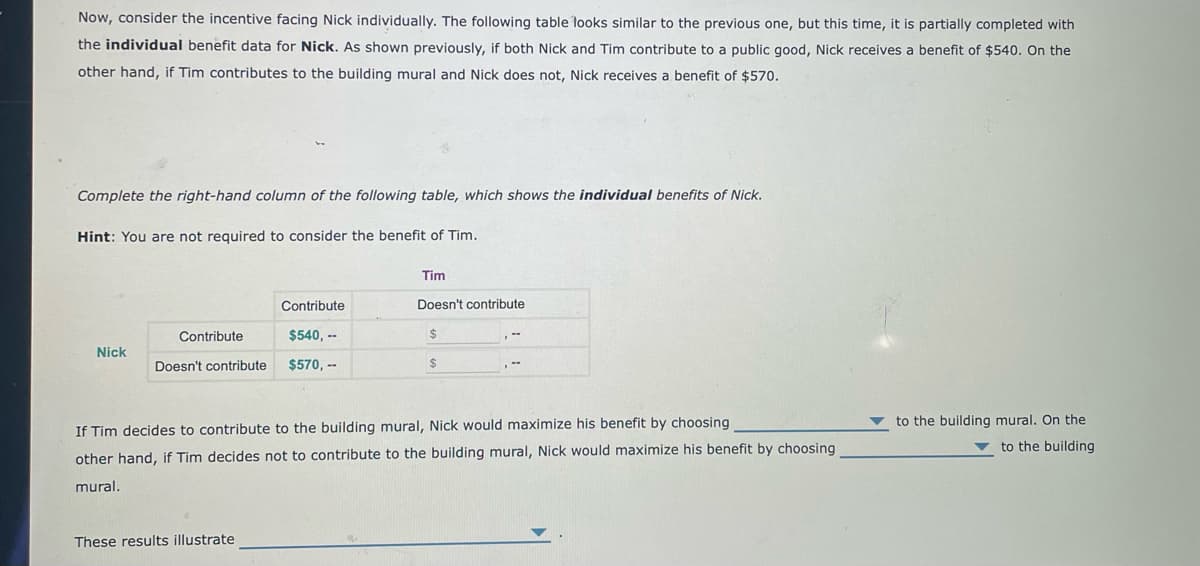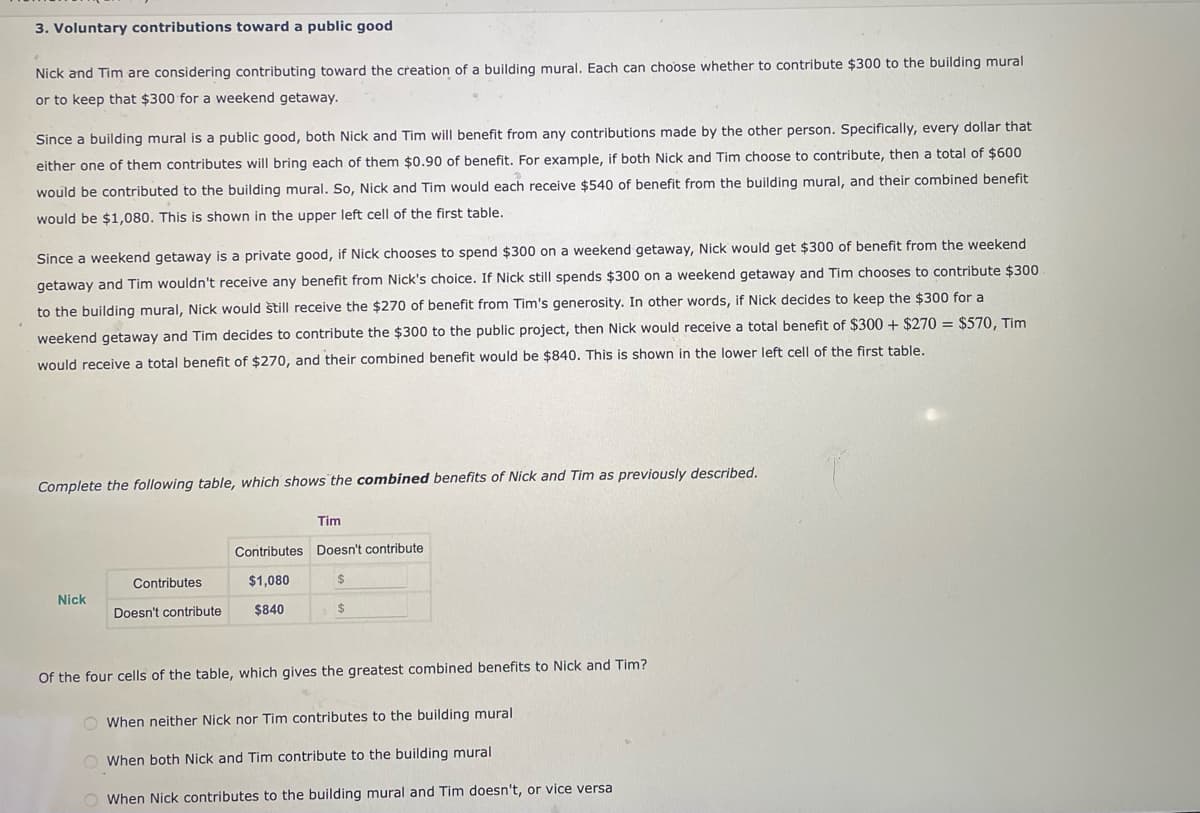that $300 for a weekend getaway. uilding mural is a public good, both Nick and Tim will benefit from any contributions made by the other person. Specifically, every dollar that e of them contributes will bring each of them $0.90 of benefit. For example, if both Nick and Tim choose to contribute, then a total of $600 contributed to the building mural. So, Nick and Tim would each receive $540 of benefit from the building mural, and their combined benefit $1,080. This is shown in the upper left cell of the first table. eekend getaway is a private good, if Nick chooses to spend $300 on a weekend getaway, Nick would get $300 of benefit from the weekend and Tim wouldn't receive any benefit from Nick's choice. If Nick still spends $300 on a weekend getaway and Tim chooses to contribute $300 Iding mural, Nick would still receive the $270 of benefit from Tim's generosity. In other words, if Nick decides to keep the $300 for a getaway and Tim decides to contribute the $300 to the public project, then Nick would receive a total benefit of $300 + $270 = $570, Tim eive a total benefit of $270, and their combined benefit would be $840. This is shown in the lower left cell of the first table. %3D the following table, which shows the combined benefits of Nick and Tim as previously described. Tim
that $300 for a weekend getaway. uilding mural is a public good, both Nick and Tim will benefit from any contributions made by the other person. Specifically, every dollar that e of them contributes will bring each of them $0.90 of benefit. For example, if both Nick and Tim choose to contribute, then a total of $600 contributed to the building mural. So, Nick and Tim would each receive $540 of benefit from the building mural, and their combined benefit $1,080. This is shown in the upper left cell of the first table. eekend getaway is a private good, if Nick chooses to spend $300 on a weekend getaway, Nick would get $300 of benefit from the weekend and Tim wouldn't receive any benefit from Nick's choice. If Nick still spends $300 on a weekend getaway and Tim chooses to contribute $300 Iding mural, Nick would still receive the $270 of benefit from Tim's generosity. In other words, if Nick decides to keep the $300 for a getaway and Tim decides to contribute the $300 to the public project, then Nick would receive a total benefit of $300 + $270 = $570, Tim eive a total benefit of $270, and their combined benefit would be $840. This is shown in the lower left cell of the first table. %3D the following table, which shows the combined benefits of Nick and Tim as previously described. Tim
Chapter2: Economic Tools And Economic Systems
Section: Chapter Questions
Problem 3.7P
Related questions
Question

Transcribed Image Text:Now, consider the incentive facing Nick individually. The following table looks similar to the previous one, but this time, it is partially completed with
the individual benefit data for Nick. As shown previously, if both Nick and Tim contribute to a public good, Nick receives a benefit of $540. On the
other hand, if Tim contributes to the building mural and Nick does not, Nick receives a benefit of $570.
Complete the right-hand column of the following table, which shows the individual benefits of Nick.
Hint: You are not required to consider the benefit of Tim.
Tim
Contribute
Doesn't contribute
Contribute
$540, --
2$
Nick
Doesn't contribute
$570, --
%24
to the building mural. On the
If Tim decides to contribute to the building mural, Nick would maximize his benefit by choosing
v to the building
other hand, if Tim decides not to contribute to the building mural, Nick would maximize his benefit by choosing
mural.
These results illustrate

Transcribed Image Text:3. Voluntary contributions toward a public good
Nick and Tim are considering contributing toward the creation of a building mural. Each can choose whether to contribute $300 to the building mural
or to keep that $300 for a weekend getaway.
Since a building mural is a public good, both Nick and Tim will benefit from any contributions made by the other person. Specifically, every dollar that
either one of them contributes will bring each of them $0.90 of benefit. For example, if both Nick and Tim choose to contribute, then a total of $600
would be contributed to the building mural. So, Nick and Tim would each receive $540 of benefit from the building mural, and their combined benefit
would be $1,080. This is shown in the upper left cell of the first table.
Since a weekend getaway is a private good, if Nick chooses to spend $300 on a weekend getaway, Nick would get $300 of benefit from the weekend
getaway and Tim wouldn't receive any benefit from Nick's choice. If Nick still spends $300 on a weekend getaway and Tim chooses to contribute $300
to the building mural, Nick would still receive the $270 of benefit from Tim's generosity. In other words, if Nick decides to keep the $300 for a
weekend getaway and Tim decides to contribute the $300 to the public project, then Nick would receive a total benefit of $300 + $270 = $570, Tim
would receive a total benefit of $270, and their combined benefit would be $840. This is shown in the lower left cell of the first table.
Complete the following table, which shows the combined benefits of Nick and Tim as previously described.
Tim
Contributes Doesn't contribute
Contributes
$1,080
2$
Nick
Doesn't contribute
$840
$4
Of the four cells of the table, which gives the greatest combined benefits to Nick and Tim?
O When neither Nick nor Tim contributes to the building mural
O When both Nick and Tim contribute to the building mural
O When Nick contributes to the building mural and Tim doesn't, or vice versa
Expert Solution
This question has been solved!
Explore an expertly crafted, step-by-step solution for a thorough understanding of key concepts.
This is a popular solution!
Trending now
This is a popular solution!
Step by step
Solved in 3 steps

Knowledge Booster
Learn more about
Need a deep-dive on the concept behind this application? Look no further. Learn more about this topic, economics and related others by exploring similar questions and additional content below.Recommended textbooks for you


Essentials of Economics (MindTap Course List)
Economics
ISBN:
9781337091992
Author:
N. Gregory Mankiw
Publisher:
Cengage Learning

Brief Principles of Macroeconomics (MindTap Cours…
Economics
ISBN:
9781337091985
Author:
N. Gregory Mankiw
Publisher:
Cengage Learning


Essentials of Economics (MindTap Course List)
Economics
ISBN:
9781337091992
Author:
N. Gregory Mankiw
Publisher:
Cengage Learning

Brief Principles of Macroeconomics (MindTap Cours…
Economics
ISBN:
9781337091985
Author:
N. Gregory Mankiw
Publisher:
Cengage Learning

Principles of Microeconomics
Economics
ISBN:
9781305156050
Author:
N. Gregory Mankiw
Publisher:
Cengage Learning

Principles of Economics, 7th Edition (MindTap Cou…
Economics
ISBN:
9781285165875
Author:
N. Gregory Mankiw
Publisher:
Cengage Learning

Principles of Economics (MindTap Course List)
Economics
ISBN:
9781305585126
Author:
N. Gregory Mankiw
Publisher:
Cengage Learning